The Future of Industry: AI Software Development
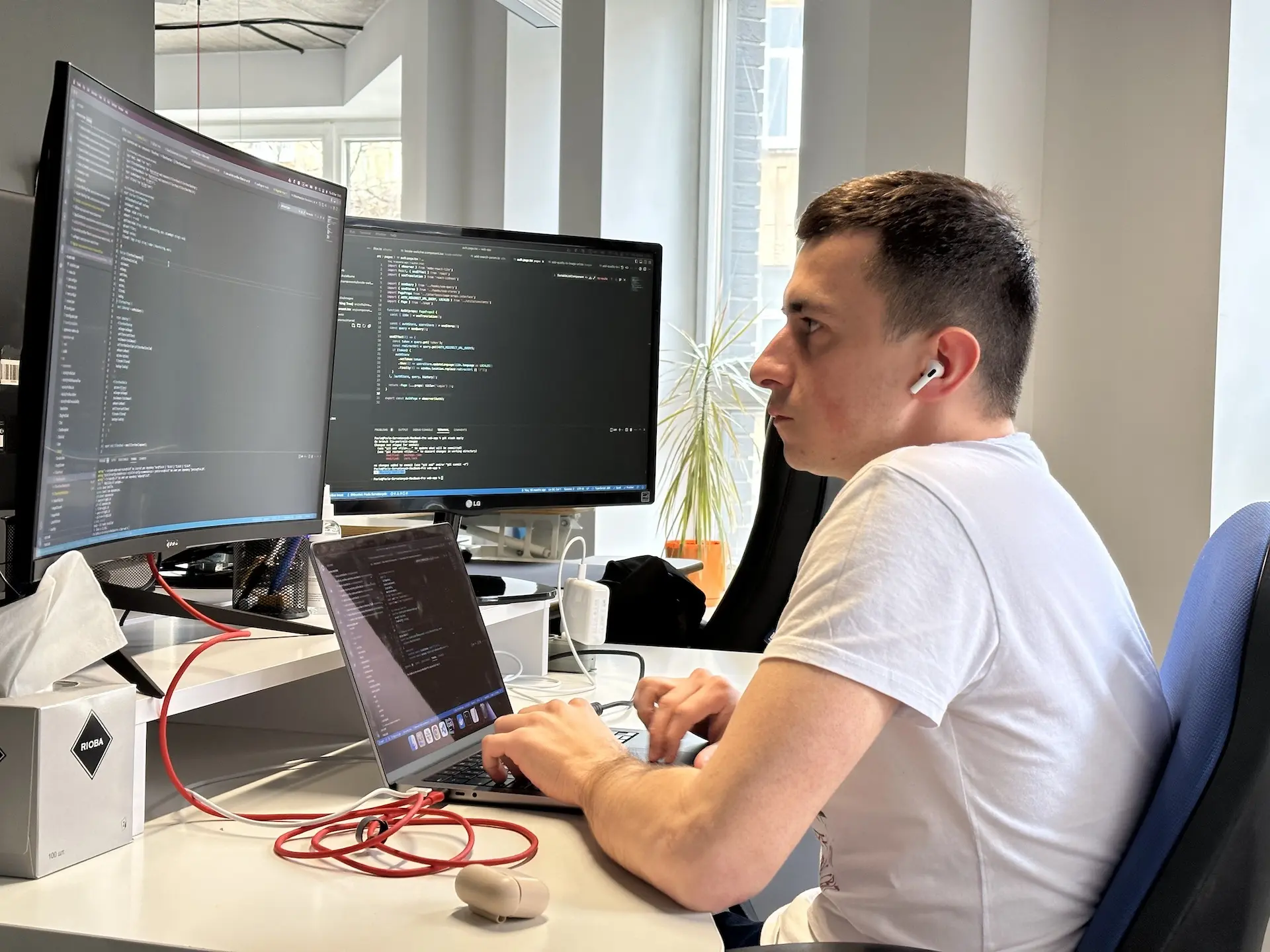
ChatGPT, GitHub Copilot, CodeGuru, and OpenAI Codex have turned the AI software development landscape upside down (in a good way, of course). These tools by AI development services help tech teams write, review, and optimize code with the precision of a laser and the speed of a caffeine-fueled coder. According to McKinsey’s latest research, businesses that use AI in their development processes can boost productivity by as much as 40%. The potential of large language models to help us do more in less time with fewer errors is nothing short of remarkable.
But how far can this revolution go with rapidly advancing AI chatbot development services? Will AI replace programmers, or are we safe from our future robot masters (at least for now)? Our AI experts decided to shed some light on the complex world of AI software development (and hopefully, this will save you from a few late-night Google searches).
Artificial Intelligence: Overview
Artificial Intelligence (AI) is defined as a technical and scientific field dedicated to creating systems that produce outputs such as content, forecasts, recommendations, or decisions based on human-defined goals [ISO/IEC 22989:2022]. While this technical definition is precise, what does it mean in simple terms?
AI is essentially a functional instrument that helps with specific, complex tasks. Its power comes from the algorithms and machine learning techniques it employs, but it demands vast amounts of data and endless repetition. Think of algorithms as intelligent systems that can analyze various pieces of information about a subject. When this algorithm is fed a large amount of training data, it creates a machine-learning model. This model can then take in new data and make decisions based on what it has learned.

Different types of AI are classified based on their level of adaptability and performance compared to humans. Advanced functions at a level similar to humans, while basic AI performs with more limited capabilities. Using this system, AI falls into four types:
1. Reactive Machines
These are the oldest type of artificial intelligence, with no memory or learning ability. They react to a limited set of inputs. Take the example of IBM’s Deep Blue, which famously triumphed over chess Grandmaster Garry Kasparov in 1997. Great at chess, but remembering birthdays? That’s another story.
2. Limited Memory Machines
These systems can do everything reactive machines do, but with a bonus: they can learn from historical data. They gather large volumes of training data, which they utilize to solve future problems. Almost all AI applications we use today, from recommendation systems to self-driving cars, fall into this category. They might not remember where they parked last week, but they know how to avoid that pothole every time.
3. Theory of Mind
AI at this level will understand human emotions, beliefs, and thoughts, treating each person as an individual shaped by various factors. While researchers are working on artificial emotional intelligence, a true theory of mind, AI is still a distant dream. It’s like trying to explain feelings to your smartphone—interesting, but we’re not quite there yet.
4. Self-aware AI
At this stage, it becomes self-aware of emotions, needs, beliefs, and possibly its own desires. Picture the “Terminator” scenario where AI thinks about self-preservation, potentially clashing with humanity. We’re talking about the next level after the theory of mind, but don’t worry; it’s likely still centuries away.
Many experts suggest that what we commonly call AI in everyday life is actually advanced machine learning, a precursor to genuine artificial intelligence, or “general artificial intelligence” (GAI). These machine learning technologies enable machines to undertake tasks that only humans could do in the past.
- Machine Learning (ML): ML enables AI models to learn from data through supervised learning with labeled information or unsupervised learning that identifies patterns in unlabeled data. Reinforcement learning, another branch, involves learning through trial and error.
- Natural Language Processing (NLP): NLP allows machines to understand and respond to human language. This technology powers applications like chatbots, language translation services, and sentiment analysis tools, which make human-computer interactions more seamless and intuitive.
- Neural Networks: Inspired by the human brain, neural networks consist of interconnected nodes (neurons) that process information in layers. They are fundamental to deep learning (DL) and are crucial for recognizing images and processing speech.
- Computer Vision: This technology lets computers interpret and understand visual information. It’s utilized in applications ranging from facial recognition to autonomous vehicles, enabling machines to “see” and appreciate their surroundings.
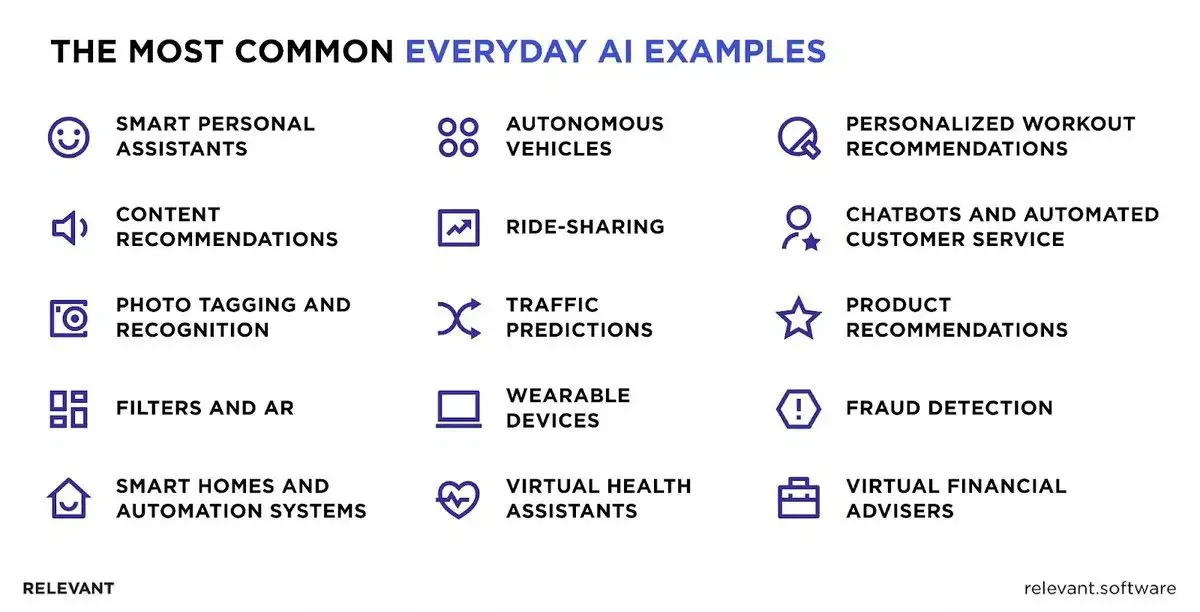
What is AI Technique?
In the real world, knowledge often has challenging characteristics:
- Immense Volume: The amount of knowledge is vast and nearly unimaginable.
- Disorganized and Unformatted: It is not always well-organized or neatly formatted.
- Constantly Changing: It evolves and changes continuously.
AI techniques provide a method to organize and utilize this knowledge efficiently, ensuring that:
- Perceivability: It is understandable to the people who provide it.
- Modifiability: It can be easily modified to correct errors.
- Versatility: It remains useful in many situations, even if it is incomplete or inaccurate.
The use of AI techniques speeds up the execution of complex programs, which results in higher efficiency and effectiveness.
Key AI Components
AI applications rely on three essential components: data, algorithms, and human feedback.
- Data: The core element of artificial intelligence software development is data. These datasets, sourced internally (e.g., trading desks, customer histories) and externally (e.g., social media, public filings) in structured and unstructured formats, drive AI applications by identifying patterns and making predictions. Continuous learning from human reviews and new information refines these predictions.
- Algorithms: Algorithms are sets of step-by-step instructions that solve specific problems using input data. Unlike traditional programming, AI algorithms are not explicitly programmed to perform tasks; instead, they learn to perform tasks through data exposure.
- Human Interaction: As data is curated and algorithms process it to generate outputs such as classifications and predictions, human experts review these results for accuracy and relevance. Such human intervention is necessary for AI systems to produce relevant and correct results, which minimize inefficiencies or potential risks.
Current Picture: How AI Transforms the Software Development World
The integration of AI into software development is transforming the industry by leaps and bounds. In a test with 40 McKinsey developers, AI-based tools delivered remarkable speed improvements. They found that documenting code for better maintainability was completed in half the usual time. Writing new code also took nearly half the time, and code optimization tasks were done in about two-thirds of the time normally required.
Let’s delve into the specific role of AI in software development:
- Automating the Mundane: AI now automates repetitive tasks like code generation, testing process, and bug fixing. Developers don’t have to spend hours fixing bugs anymore. They can let machines handle the boring tasks and enjoy the more interesting parts of their jobs.
- Boosting Code Quality: AI can analyze vast amounts of code to identify patterns and potential vulnerabilities. This allows developers to generate cleaner, more secure code with fewer bugs. For example, GitHub Copilot has been trained on billions of lines of code and can suggest entire blocks of code, which speeds up the development process and helps reduce errors.
- Smarter Project Management: AI in software development can predict potential roadblocks and bottlenecks in development projects. This foresight enables developers and project managers to allocate resources more effectively and adjust timelines proactively for smoother and more efficient development cycles.
- Personalized Development Assistance: AI-powered tools can suggest code completions, recommend best practices, and even identify potential improvements in available code. This customized guidance helps developers write more efficient code and make informed decisions throughout development.
This comparison shows the transformative impact of AI software development.
| Aspect | Programming Without AI | Programming With AI |
| Code Writing | Manual code generation; developers write each line of code themselves. | AI-assisted coding with tools like GitHub Copilot, suggesting code snippets and auto-completing lines. |
| Debugging | Developers manually search for and fix bugs in the code, which can be tedious and requires an in-depth knowledge of the codebase. | AI-powered debugging tools identify bugs and suggest fixes automatically. |
| Code Review | Code reviews are conducted by peers, which can be a slow process depending on the availability and workload of team members. | AI-augmented tools provide instant code reviews, highlighting potential issues and improvements. |
| Optimization | Developers need to manually optimize code, which requires extensive knowledge of best practices and performance considerations. | AI algorithms optimize code for performance and efficiency automatically, simplifiyng technical debt management. |
| Documentation | Developers create and update documentation manually, which can be tedious and is often neglected. | It keeps documentation comprehensive and up-to-date based on code AI analysis. |
| Error Detection | Errors are typically detected under compile time or runtime, often after significant development has already occurred. | AI provides immediate feedback through error detection and code corrections. |
| Productivity | Productivity varies based on the individual developer’s skill and experience, and manual processes can slow down development. | AI enhances productivity through smart suggestions and repetitive task automation. |
| Creativity | Developers draw on their expertise and background to develop creative solutions and introduce new ideas. | AI inspires creativity by innovative approaches and solutions. |
| Maintenance | Frequent code updates and maintenance involve manual work, which can be labor-intensive and prone to mistakes. | AI predicts necessary updates and automates routine maintenance tasks, keeping code up-to-date and reducing manual workload. |
| Security | Security vulnerabilities are identified through manual review or after a breach has occurred, making it difficult to ensure comprehensive protection. | AI constantly checks for security weaknesses, delivering instant alerts and automated repairs to boost the security of the codebase. |
| Testing | Developers conduct extensive manual testing across various scenarios to ensure code functionality and stability. | AI testing tools automate test case creation and execution, improving coverage and accuracy while saving time. |
As you might notice, AI cuts down on manual tasks, enhances skills through smart automation, and boosts software development. This transformation makes the process of AI software development more efficient, precise, and innovative.
AI Trends To Watch
To remain competitive, IT professionals and businesses must keep up with the latest AI trends. Here’s an overview.
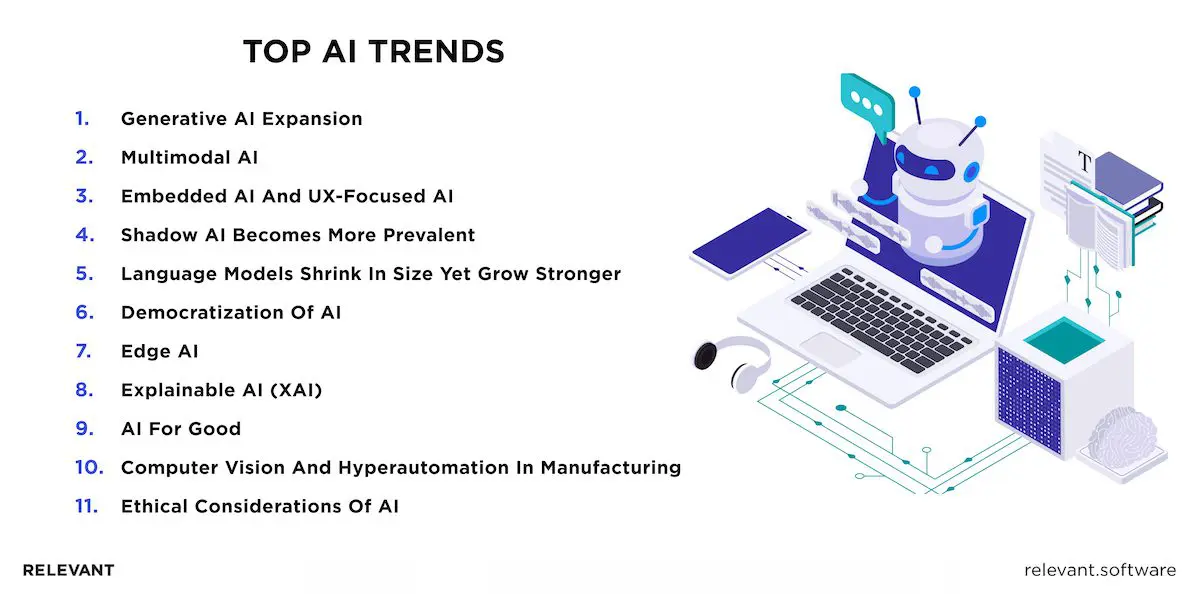
Generative AI Expansion
The reach of generative AI is extending beyond its traditional text and image confines, venturing into video, 3D models, and even sensory experiences like smell and taste. Generative AI will match median human performance by the end of this decade and compete with the top 25 percent of human performance on various tasks by 2040. Spoiler alert about generative AI in software development: future models will be trained on vast, unlabeled datasets, which allows them to perform multiple tasks with minimal fine-tuning.
Multimodal AI
Multimodal models can process and integrate various types of data—text, audio, video, and images— which leads to more seamless and intuitive applications. These models are being used in smartphones to identify objects in photos, boosting user experiences by integrating multiple data types for richer interactions. An example of multimodal AI is OpenAI’s GPT-4V(ision), which can understand and process both images and text.
Embedded AI and UX-Focused AI
With the embedded AI platform market expected to expand by 5.4% annually, industry experts highlight the benefits of AI model integration into third-party systems. This translates into the creation of AI-powered search and assistance functions, which enhance user interactions and provide businesses with a competitive edge in customer experience management.
Shadow AI Becomes More Prevalent
Shadow AI is on the rise as employees use AI technologies without formal IT department approval, causing a lack of oversight in AI implementation across organizations. This trend is driven by the accessibility and user-friendliness of current tools, which empower departments to independently deploy AI solutions. While shadow AI can drive innovation and allow departments to solve problems quickly, it introduces security risks and inefficiencies due to unmonitored applications.
Language Models Shrink in Size Yet Grow Stronger
Small Language Models (SLMs) are becoming more powerful, offering high performance with fewer parameters. Innovations from tech companies like Microsoft highlight SLMs’ potential to match larger models in specific tasks. SLMs reduce computational demands, which makes AI more accessible and sustainable. However, achieving high performance requires carefully curated training data, and SLMs generally do not yet match the broad capabilities of larger models.
Democratization of AI
AI tools and resources are now more accessible and user-friendly, which means businesses of all sizes can harness AI capabilities. Cloud-based solutions and pre-trained models are lowering the barrier to entry. For example, Kaggle, a platform for data science competitions, has over 5 million users who share and collaborate on AI models and datasets, which significantly contributes to the spread and accessibility of AI knowledge.
Edge AI
Edge AI processes data close to its source. This shift in AI software development enables faster decision-making and reduces latency, which is critical for applications like the Internet of Things (IoT) and real-time automation. For example, edge AI processes sensor data locally in autonomous vehicles, enabling them to make split-second driving decisions without waiting for cloud-based instructions. This trend enhances the efficiency and reliability of systems that require immediate responses.
Explainable AI (XAI)
As AI models advance in complexity, understanding how they arrive at decisions becomes more critical. Explainable AI (XAI) is focused on making these systems more interpretable and transparent. This involves techniques that let humans to see inside the “black box” of AI and understand the rationale behind its outputs. In healthcare, for instance, XAI can help doctors see why an AI system recommends a specific treatment, making it more likely that they will trust and act on the AI’s advice.
AI for Good
AI will be increasingly used to address global challenges such as climate change, poverty, and healthcare. Modern systems can analyze vast datasets to identify patterns and insights that inform solutions and improve resource allocation. For example, AI models can predict weather patterns to help farmers optimize crop yields or analyze medical records to identify disease outbreaks early. The AI software development for good movement emphasizes using technology to create positive social impact and drive sustainable solutions.
Computer Vision and Hyperautomation in Manufacturing
Hyperautomation, powered by AI and computer vision, transforms traditional production processes. Computer vision enables machines to interpret their environments visually, leading to increased precision and faster production rates. It also improves safety by continuously monitoring industrial facilities for potential hazards. However, the initial setup cost for state-of-the-art computer vision systems is substantial, and heavy reliance on automation can make processes vulnerable to technical failures and cybersecurity threats.
Ethical Considerations of AI
As AI and software development becomes more sophisticated, ethical concerns surrounding bias, transparency, and accountability are coming to the forefront. The European Union, for example, is expected to pass comprehensive regulations to safeguard consumer interests. Responsible development and deployment of fair, unbiased AI that adheres to ethical principles will be crucial for its long-term success.
Will AI Replace Programmers?
As AI technology evolves, it brings up conversations about the future of artificial intelligence software development and whether it might reduce the need for human programmers. However, fears of AI completely overtaking the role of programmers seem a bit premature.
In truth, AI is far from ready to replace software developers. Even with its customization capabilities and targeted applications, its limitations are too significant.
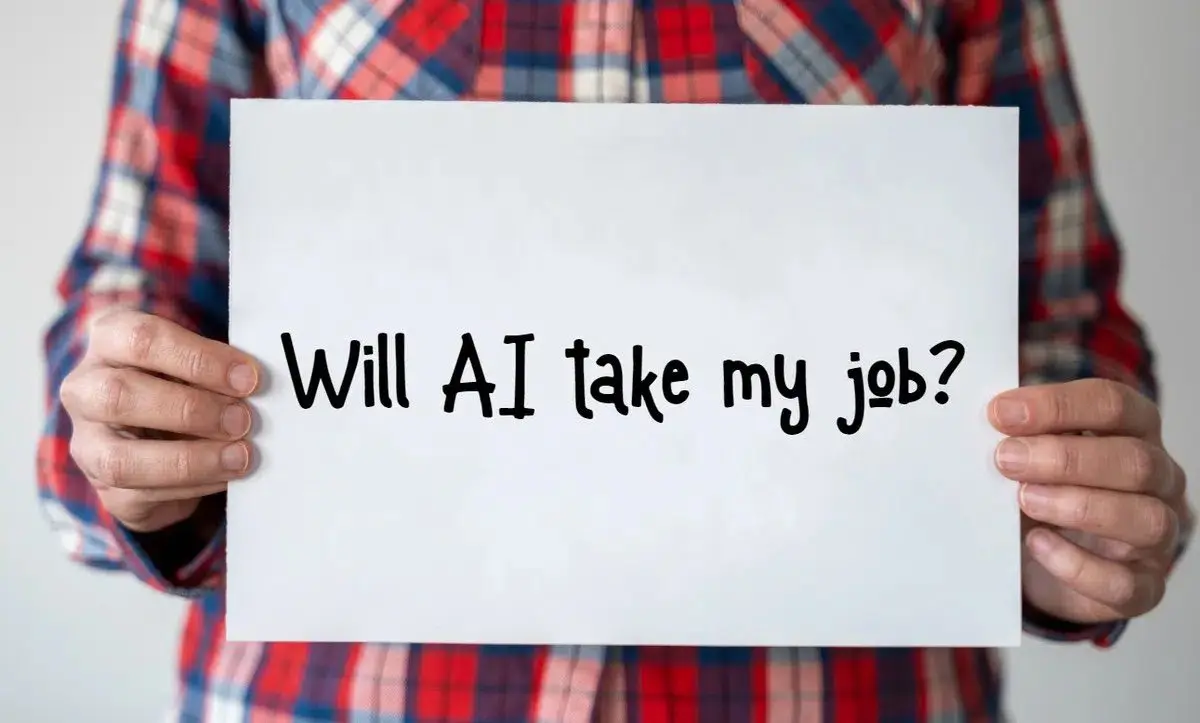
However, it is changing the way software engineers work. 70% of developers say that AI coding tools enhance their ability to complete tasks and boost productivity. Experts agree that while AI can automate repetitive tasks and assist in debugging, 80% of programming jobs will still need a human touch.
Complex Coding Requirements
Some projects require developers to manage multiple, often conflicting, requirements. While AI can respond to specific prompts and generate code snippets, it struggles to manage complex criteria while maintaining a holistic project view. Developers ensure that all aspects of the project align with the overall goals and expectations, something AI currently cannot do.
Contextual Outputs and Organizational Knowledge
AI-generated code often lacks the context of an organization’s unique preferences and standards. That means the programs it creates might not meet your security, performance, or compliance requirements. Human developers must tailor AI outputs and align AI software development with the company’s strategic initiatives and organizational knowledge.
Broader Strategic Approaches
AI excels at performing narrowly defined tasks, but it falls short when aligning its outputs with broader strategic goals. While AI can create functional programs, human developers must ensure that these programs fit within the larger framework of the organization’s software ecosystem. This includes stylistic consistency, functional alignment, and long-term strategic planning.
Autonomous Action
AI software development relies on inputs to generate outputs. Current AI systems, particularly generative ones, create text or code based on prompts and predict subsequent elements. However, they lack true autonomy. AI can’t independently decide to undertake a task without explicit instructions, which means human oversight is always necessary to guide and refine AI-generated content.
Domain Expertise
In the finance, healthcare, and scientific computing sectors, programmers with domain knowledge will be essential for success. They can employ their experience of the specific challenges and regulations to develop customized software solutions that effectively address those needs.
The future of artificial intelligence software development doesn’t pit humans against AI; instead, it envisions a collaborative partnership between the two. Programmers who embrace AI tools and hone the skills to work alongside them will be best positioned for success. They were more than twice as likely to report higher happiness, fulfillment, and flow levels.
Benefits of Outsourcing AI Software Development
As AI technology evolves rapidly, the demand for experts in this field rises. Many companies find their internal teams can’t keep up with these rapid changes, prompting them to turn to AI outsourcing. Here’s a breakdown of the key benefits of AI and software development through outsourcing:

1. Access to Specialized Talent
Finding and keeping the best AI experts can be a considerable challenge. However, outsourcing AI software development helps you tap into a global pool of skilled developers with expertise in specific domains like machine learning, deep learning, data science and computer vision. This ensures your project is staffed by individuals with the right skill set and experience to extract valuable insights from unstructured data and deliver optimal results.
2. Cost-Effectiveness
Developing an in-house AI team involves substantial hardware, software, and continuous training costs. Outsourcing artificial intelligence software development allows companies to benefit from pre-established infrastructure and expertise, generally at a reduced price.
3. Faster Time to Market
Outsourcing partners often have well-established AI and software development processes and best practices. This strategy can significantly reduce the development timeline, permitting your AI solution to reach the market more quickly, seize new opportunities, and stay ahead of competitors.
4. Scalability and Flexibility
Your AI software development needs may fluctuate depending on project requirements. By outsourcing, you can adjust your development team size according to your needs, with more flexibility and cost benefits than a constant in-house team.
5. Cutting-Edge Technology
Top outsourcing providers frequently invest in the latest AI tools and technologies. When you outsource, you benefit from this advanced infrastructure, enabling you to apply the most modern solutions to your project without substantial upfront operational costs.
6. Innovation and Fresh Perspectives
Outsourcing partners with extensive experience from diverse projects across multiple industries can bring fresh perspectives and innovative strategies to your artificial intelligence software development.
Outsourcing can be hugely beneficial, but it’s important to recognize potential challenges in AI software development:
- Effective remote communication and collaboration are crucial for successful outsourcing. Clear channels and established processes help manage expectations and maintain project alignment.
- When outsourcing AI software development, sensitive data may be involved. Conduct a thorough vetting of outsourcing partners to ensure they have stringent data security protocols and compliance measures.
- Establish ownership rights for any IP developed during the outsourcing process in a formal agreement.
Industry-Specific Applications of AI
From healthcare to finance, AI technologies drive innovation and efficiency and change how businesses operate and deliver value. Let’s closely look at how AI improves specific sectors:
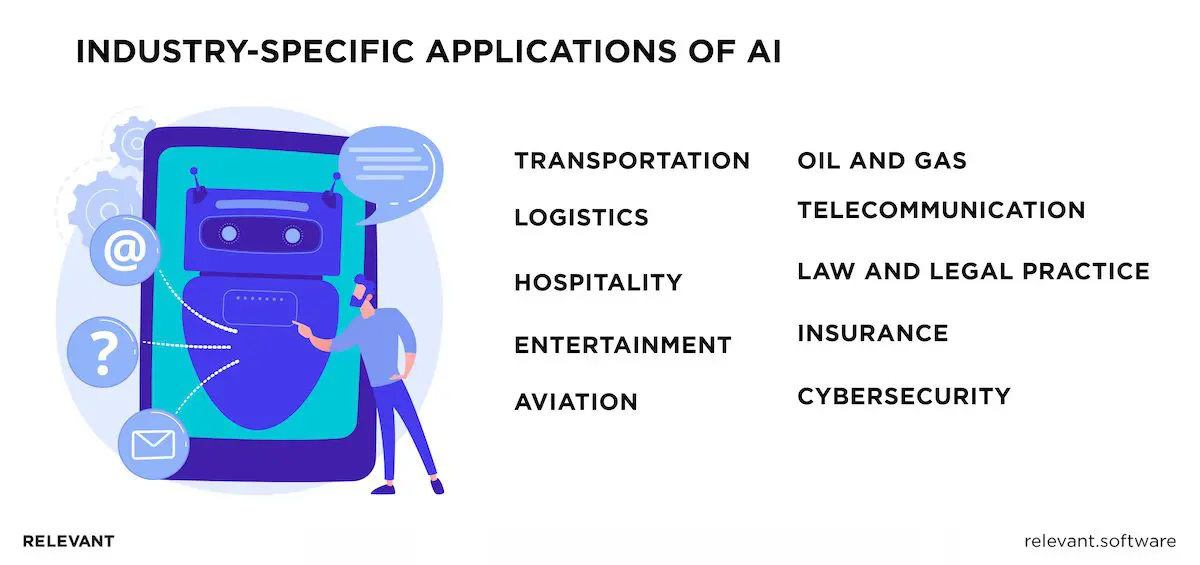
AI in Transportation
The integration of AI into transportation systems addresses long-standing challenges and unveils new possibilities for innovation. Here are some key areas where AI software development has a major impact:
- Self-Driving Cars: Autonomous vehicles use advanced algorithms to perceive their environment through cameras, LiDAR, and radar. They make informed decisions based on traffic rules and real-time data, navigating roads safely with sophisticated path planning and obstacle avoidance techniques.
- Traffic Flow Optimization: Modern technology evaluates real-time traffic data, such as sensor inputs, GPS coordinates, and historical trends, to dynamically adjust traffic light timings, improving traffic flow and reducing congestion.
- Predictive Maintenance: Advanced systems analyze vehicle sensor data, including engine diagnostics and tire pressure, to predict potential mechanical issues before they result in breakdowns, ensuring smoother and more reliable vehicle performance.
AI in Logistics
AI in logistics transforms how goods are transported from factories to consumers, bringing about notable enhancements in speed, efficiency, and reliability.
- Optimized Transportation: Advanced algorithms help plan efficient truck routes by considering real-time traffic and weather conditions. This speeds up deliveries and cuts down on fuel costs.
- Demand Forecasting: By analyzing historical data and market trends, predictive analytics accurately forecast future demand. This allows logistics companies to strategize inventory management, avoid stockouts, and ensure timely deliveries.
- Smart Warehouses: Autonomous robots, guided by sophisticated software, navigate warehouses to streamline picking and packing processes. Additionally, these systems optimize warehouse layouts for maximum efficiency, reducing travel distances for both robots and human workers, thus boosting productivity.
AI in Hospitality
AI in the hospitality industry is being used to tailor experiences for travelers and guests and streamline operational processes. Here are some ways AI software development is transforming hospitality:
- Personalized Recommendations: Advanced data analysis offers guests tailored suggestions for activities, restaurants, and attractions based on their individual preferences.
- Improved Guest Services: Chatbots and virtual assistants provide round-the-clock support, handling inquiries, managing requests, and facilitating reservations efficiently.
- Proactive Maintenance: By analyzing sensor data, predictive systems can foresee potential issues with equipment or building systems, ensuring guest comfort and preventing disruptions.
AI in Entertainment
From personalized recommendations to immersive experiences, AI is indispensable for the entertainment industry. Here’s a look at some exciting applications of AI in entertainment:
- Content Creation: Technology assists human creators by generating scripts, composing music, and crafting special effects, enhancing the creative process.
- Tailored Recommendations: Advanced systems analyze user data to suggest movies, music, and shows that match individual preferences, offering a personalized entertainment experience.
- Interactive Experiences: Technology enhances movies and video games with more realistic and immersive special effects, significantly boosting the overall customer experience.
AI in Aviation
The aviation industry, a crucial part of our global connectivity, embraces AI for software development to enhance safety and efficiency. Here are some key AI in aviation applications that excite:
- Fuel Efficiency and Maintenance Optimization: Advanced systems analyze flight data to optimize flight paths, which saves airlines fuel and reduces costs. They can also predict potential maintenance issues in aircraft, which ensures safety and prevents delays.
- Passenger Experience: Smart chatbots can handle customer inquiries, provide real-time flight updates, and offer personalized in-flight entertainment options, enhancing the overall travel experience.
AI in Oil and Gas
Crucial for energy production, the oil and gas industry uses AI to optimize operations and improve safety measures. Examples of AI for software development in this field are:
- Reservoir Exploration: Advanced technology interprets seismic data more efficiently, identifying potential oil and gas reserves with greater accuracy.
- Predictive Maintenance: Systems predict equipment failures in oil rigs and pipelines, minimizing downtime and enhancing safety.
- Optimized Operations: Robotic Process Automation (RPA) and advanced systems streamline drilling and production workflows, boosting efficiency and reducing costs significantly.
Read more about AI in oil and gas here.
AI in Telecommunication
The telecommunication industry turns to AI to improve network performance and enhance customer service. Here’s how AI in telecommunication is making a difference:
- Network Optimization: By analyzing real-time traffic patterns, AI can foresee potential bottlenecks and proactively manage the network. This means fewer dropped calls and a smoother internet experience for everyone.
- Fraud detection: AI algorithms can identify and prevent fraudulent activities such as unauthorized access or sim-swapping, protecting telecommunication companies and their customers.
- Personalized customer service: AI-powered chatbots can handle routine customer inquiries, freeing up human representatives for more complex issues. Additionally, AI can analyze customer data to personalize recommendations for plans and services.
AI in Law and Legal Practice
The legal profession traditionally relies heavily on human expertise and precedent. However, AI in law and legal practice has made significant strides and has helped lawyers with various tasks. For instance, tools developed by AI software development companies can help you with::
- Legal Research: Advanced tools sift through a vast array of legal documents, locating relevant case law and statutes, which saves lawyers a great deal of time and effort.
- Contract Review: With sophisticated analysis, lawyers can scrutinize contracts, spot potential issues, and ensure accuracy, thereby reducing the risk of errors.
- E-Discovery: Advanced systems streamline the process of discovering relevant electronic documents in legal cases, making a historically complex and cumbersome task more manageable.
AI in Insurance
The insurance industry utilizes AI software development to assess risk more accurately, streamline claims processing, and even personalize insurance policies. Here are some examples of AI impact:
- Fraud Detection: Advanced algorithms analyze insurance claims data to spot potential fraudulent activity, reducing costs for both insurance companies and policyholders.
- Risk Assessment: By examining data such as driving records and medical history, advanced systems provide a more accurate picture of an individual’s risk profile, leading to fairer pricing of insurance policies.
- Claims Processing: Automation handles tasks like document review and information verification, streamlining the claims process and boosting customer satisfaction.
Related – AI in insurance
AI in Cybersecurity
As cyber threats grow more sophisticated, the importance of AI software development in defending our digital infrastructure has increased significantly. AI systems can help in:
- Threat detection and prevention: Algorithms can analyze network traffic to identify malicious activity and potential cyberattacks in real-time. In such a way, security professionals can respond quickly and mitigate threats before they cause damage.
- Vulnerability management: AI can identify vulnerabilities in software systems and prioritize them based on risk. This helps security teams focus their efforts on the most critical issues.
- Phishing detection: Algorithms can analyze emails and messages to detect phishing attempts that seek to steal personal information, which protects against cyber scams.
Read more about AI in cybersecurity.
As you can see, AI software development brings rapid transformations to numerous industries, with significant advancements and exciting possibilities for the future of software engineering. While we do need to navigate challenges like ethics and employment issues, the potential of AI for software development and, by extension, our daily lives is huge and, let’s be honest, a bit thrilling.
For more deeper insights, read our guide to AI in Web Development
Integration of AI and IoT
The possibilities are vast, from healthcare, where AI and IoT can monitor patient health and predict medical issues, to energy management, where they can optimize power usage and reduce waste. Here’s how AI and IoT work together:
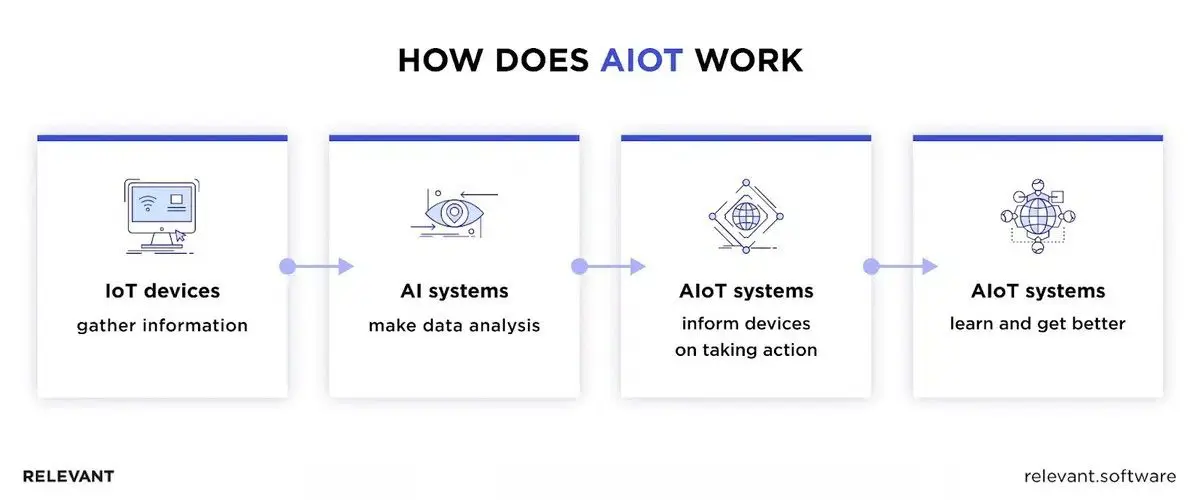
Healthcare: IoT devices such as wearable fitness trackers and smart medical devices collect health data, which AI then processes to provide personalized health insights, early diagnosis, and predictive analytics for better patient care.
Industrial Automation: In manufacturing, IoT sensors monitor equipment and production lines. These sensors provide real-time data, which helps predict maintenance needs and prevent costly downtime. For instance, sensors can detect temperature changes or unusual vibrations in machinery, which enables AI to schedule maintenance before a breakdown occurs, thus maintaining continuous production flow.
Smart Cities: Urban sensors gather data on traffic patterns, air quality levels, and energy consumption. With this data, AI can improve traffic flow, manage resources efficiently, and enhance the quality of life for city dwellers.
Agriculture: IoT devices in the field monitor soil moisture levels, local weather patterns, and crop health. AI uses this information to optimize irrigation, predict pest outbreaks, and boost crop yields, making agriculture more sustainable and productive.
Retail: IoT devices track inventory and customer behavior in stores. AI processes this data to manage stock levels, streamline supply chains, and personalize customers’ shopping experiences.
Build an AI Solution with Relevant Software
Building an AI system from scratch might seem like trying to construct a spaceship in the garage, but don’t worry – we’ll break it down into manageable steps. You’ll be surprised how straightforward it can be if you are guided by our AI software development company (and no, you don’t need a PhD in computer science to follow along).
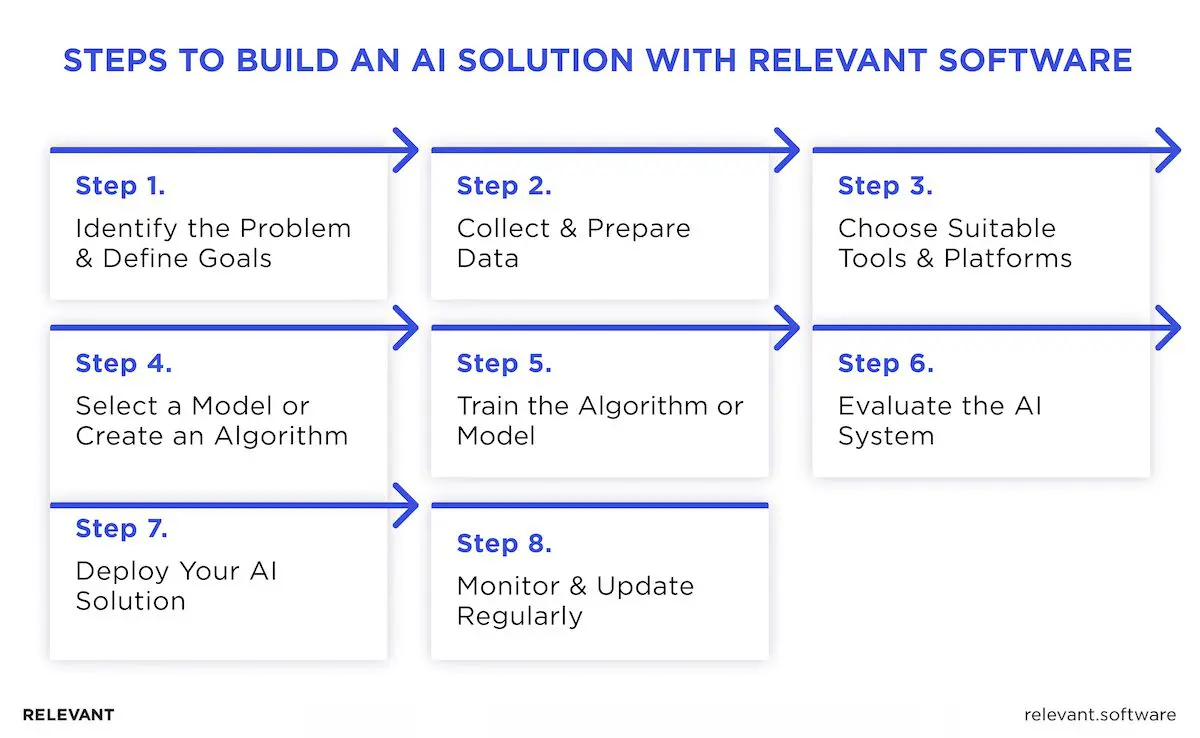
Step 1: Identify the Problem & Define Goals
The first step in AI software development is to clearly define the problem you want to solve and set measurable goals. For instance, if you aim to improve customer service efficiency, your goal might be to reduce response times by 50% with AI chatbots.
To ensure the problem is suitable for AI, consider its feasibility: Can it effectively address this issue? Analyze the potential positive outcomes for your organization if this issue is resolved and how it will enhance operations. Lastly, evaluate data availability: Do you have access to quality data related to this problem? These factors will guide the initial steps and shape the overall direction of your AI project.
Step 2: Collect & Prepare Data
High-quality, relevant datasets are undoubtedly the foundation of all AI systems. You might source data through web scraping tools, API calls, or manual data collection. Once collected, it is essential to clean and preprocess these data to ensure it remains accurate and consistent. This means addressing missing values, correcting inconsistencies, and removing outliers. You can use Python’s Pandas library to handle these tasks efficiently.
The relevance of the data to your defined problem is paramount; irrelevant data can hinder the AI’s learning process. Balancing the volume of data is essential, as too much data can be as detrimental as too little.
Step 3: Choose Suitable Tools & Platforms
Cloud-based platforms such as AWS and Google Cloud offer scalability and significant computational power, making them suitable for large-scale AI projects. Alternatively, local servers might be preferred for enhanced data security and control.
Select tools, considering your available tech stack’s ease of use, scalability, community support, and integration capabilities. Tools with intuitive interfaces and comprehensive documentation, such as TensorFlow’s Keras API and PyTorch’s syntax, reduce the learning curve and accelerate AI-based software development.
For example, cloud platforms like AWS can provide the necessary infrastructure if your project requires heavy data processing. At the same time, Python, with its rich ecosystem, can handle the coding and algorithm development.
Step 4: Select a Model or Create an Algorithm
Whether to create a new algorithm or utilize an existing model depends on the problem’s complexity, the amount of data, and the team’s expertise. To develop an algorithm from scratch, your team necessitates proficiency in Python or R and a solid foundation in ML principles.
Alternatively, pre-trained models, available through platforms like TensorFlow or PyTorch, can be fine-tuned to meet your needs. For instance, if you work on an NLP project, you might use a pre-trained BERT model and fine-tune it with your data.
Consider the computational resources required, as some models demand more processing power. Balance accuracy with speed in artificial intelligence software development – highly accurate models may take longer to train and execute. Finally, ensure the model is interpretable so you can understand and explain its decision-making process.
Step 5: Train the Algorithm or Model
To train your model, you need to provide it with data, which it uses to learn and improve its accuracy and effectiveness. This necessitates a substantial dataset, often split into training and validation sets. TensorFlow, PyTorch, or Keras provide the means to manage the training process and modify parameters for better performance.
The quality of the data input is crucial in artificial intelligence software development. Clean, relevant data ensures the model learns effectively. Be cautious of overfitting, where the model excels with instructional data but struggles with new data, and underfitting, where it doesn’t learn enough from the data set.
Striking a balance is key. For instance, a retail company might leverage past sales data to train a model to forecast future trends. Regular adjustments and validations under training help to refine the model for better accuracy and performance.
Step 6: Evaluate the AI System
A robust performance evaluation is necessary to confirm that your AI system meets its intended goals. You can measure its accuracy and reliability through cross-validation, precision-recall, ROC curves, and confusion matrices. Tools like TensorFlow and Scikit-Learn offer robust functionalities for a comprehensive evaluation.
Be sure to check for overfitting or underfitting by comparing how the model performs on both training and unseen data. Address any biases in your model to keep it fair and accurate. Finally, test the model in real-world scenarios to measure its practical applicability.
For example, if you’ve developed an AI model for fraud detection in banking, evaluate its accuracy with historical transaction data and then test it with real-time transactions to gauge its effectiveness.
Step 7: Deploy Your AI Solution
The deployment phase of your AI solution involves incorporating it into your current systems or workflows. Depending on your specific needs, you might implement APIs for interoperability or develop a custom user interface for end-users. Deployment tools like Docker and Kubernetes can manage the deployment process and guarantee scalability through artificial intelligence software development.
Ensure the solution is compatible with your current systems, can handle increased data or user load, and has robust security measures to protect sensitive data. Establish monitoring mechanisms to track performance and promptly detect issues throughout AI software development.
For instance, deploying an AI-driven recommendation engine on an e-commerce platform requires seamless integration with the website’s backend and real-time processing capabilities to provide personalized suggestions to users.
Step 8: Monitor & Update Regularly
Continuous monitoring of your system post-deployment is crucial in artificial intelligence software development. This involves performance tracking, error identification, and necessary updates. Tools like TensorFlow’s TensorBoard or Google’s Cloud Monitoring facilitate this process.
Pay attention to changing data patterns and retrain your model if new trends emerge. Regularly assess whether your model aligns with business goals and be prepared for maintenance to keep the system up-to-date with technological advancements.
For example, a financial institution that uses an AI model for credit scoring should continuously monitor its performance to adapt to market conditions and regulatory requirements.
Best Practices in AI Software Development
While many of these guiding principles for AI software development have been covered above, it’s worth reiterating their importance:
- Use Relevant, Quality Data: Your system is only as good as the data it learns from. Ensure your data is clean, well-organized, and representative of the problems you want to solve. Incomplete or biased data can lead to inaccurate predictions and poor performance, so invest time in robust data management practices.
- Choose Appropriate Models: Align your model selection with the problem’s complexity and data size. For example, simpler models might work well for basic classification tasks, while more complex models, such as DL networks, might be needed for image recognition or natural language processing. For applications where understanding the decision-making process is crucial, choose models that provide clear insights into decisions (e.g., logistic regression).
- Regularly Evaluate and Refine: AI models are not static; they need continuous evaluation and refinement. Make it a point to periodically retrain the model with new data to keep it responsive to changes and performing at a high level.
- Be Ethically Responsible: Ensure your system doesn’t perpetuate harmful biases or compromise user privacy. Use bias detection and mitigation methods during your model’s training to enhance fairness. Comply with data protection regulations like GDPR and CCPA to ensure user information remains secure.
Embracing these practices and leveraging our AI software development expertise will enable you to navigate AI implementation’s complexities and realize its full potential for your business.
AI Software Development: Final Thoughts
At Relevant, we’re big fans of the AI revolution. We train our developers extensively to harness the power of AI, making their work faster and their products top-notch.
So, whether you want to leverage artificial intelligence software development for enhanced efficiency or need a reliable AI software development company to bring your vision to life, we are here to help.
Relevant ensures your business gets top-tier, time-zone-aligned AI software engineers. By partnering with us, you can prioritize innovation and business expansion, confident that your AI projects are being expertly overseen. Contact us!



